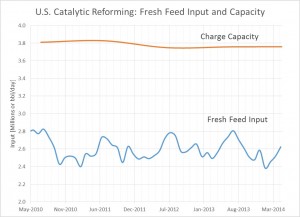Catalytic reforming is a necessary chemical process used in the petroleum refining industry which takes in straight run naphtha or partially treated light straight run naphtha, depending on the process, as a feedstock and converts it into high octane reformate and gasoline products. The earliest catalytic conversion processes date back as far as the 1930’s, however they have been continually improved upon since then with advances in techniques, catalysts, and yields to meet governmental product requirements. There are several different processes that are designated into classifications based on how their individual catalyst regeneration systems work. Those classifications are: semi-regeneration, cyclic regeneration, and continuous regeneration. Older catalytic reforming processes are typically semi-regenerative while cyclic and continuous regeneration processes are newer more advanced strategies.
Semi-regenerative methods, while useful, can be problematic because they must be turned off on a scheduled basis for the regeneration process to take place. These scheduled outages mean that the refineries cannot generate products and are therefore losing money while the units are offline. Cyclic units sought to resolve some of these issues by introducing another reactor to a two or three reactor system so that while one is turned off for regeneration the others could continue running and producing high octane fuels. The most up-to-date practices use continuous regeneration which requires no shutdown time because catalysts are momentarily removed from the reaction process, regenerated, and then introduced back in to continue the transformation of low octane feedstocks to high octane products. Continuous processes appear to be the best way to go except that they are the most expensive and most technically involved of the three methods.
Besides the regeneration methods, catalytic reforming processes, such as alkylation, dealkylation, polymerization, isomerization, and disproportionation1, have their own advantages and disadvantages as well. Sulfur is a major issue for catalysts because it will poison the catalysts causing them to be unable to function so hydrogenation must occur prior to any of these catalytic reforming processes taking place to remove sulfur. Dehydrogenation and dehydrocylcinization as overall processes can also be problematic because they can create aromatic compounds which are regulated by the U.S. government due to their nature as carcinogens. The procedure of alkylation has an advantage over other practices in this respect because it does not produce any aromatic compounds which is why it is favored in use over other reforming types.2 Alkylation is not without its drawbacks though, while it yields no aromatics alkylation does require the use of highly concentrated acids, such as hydrofluoric or sulfuric acid1. Acids such as these can be dangerous to human health as well as the environment 3 4.
- “CIEC Promoting Science at the University of York, York, UK.” Cracking and related refinery processes. N.p., n.d. Web. 10 July 2014. <http://www.essentialchemicalindustry.org/processes/cracking-isomerisation-and-reforming.html>.
- Eser, Semih. “Alkylation.” FSC 432: Petroleum Processing. N.p., n.d. Web. 12 July 2014. <https://cms.psu.edu/section/content/default.asp?WCI=pgDisplay&WCU=CRSCNT&ENTRY_ID=F20C6357261A4AE2A750C141B
- “Hydrogen Fluoride (Hydrofluoric Acid).” CDC. N.p., n.d. Web. 11 July 2014. <http://www.bt.cdc.gov/agent/hydrofluoricacid/basics/facts.asp>.
- “Sulfuric acid .” Centers for Disease Control and Prevention. Centers for Disease Control and Prevention, 18 Nov. 2010. Web. 12 July 2014. <http://www.cdc.gov/niosh/npg/npgd0577.html>.

